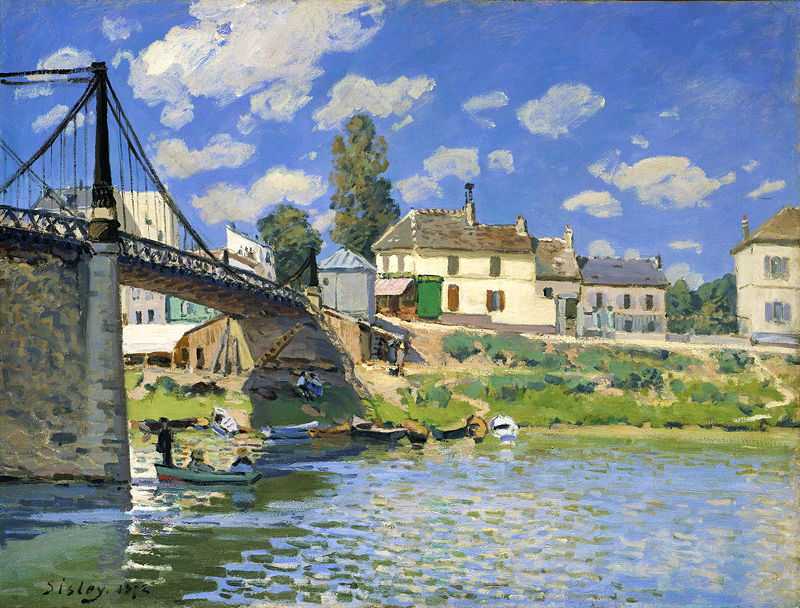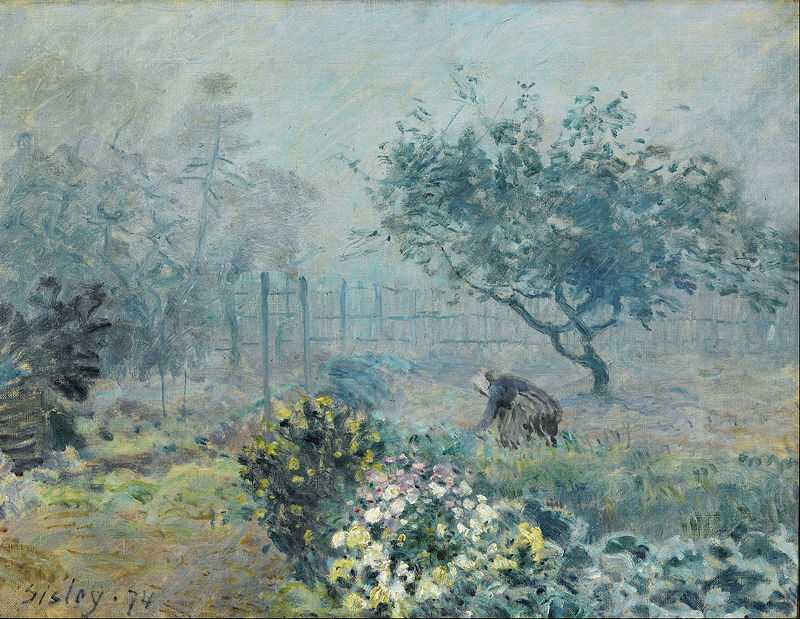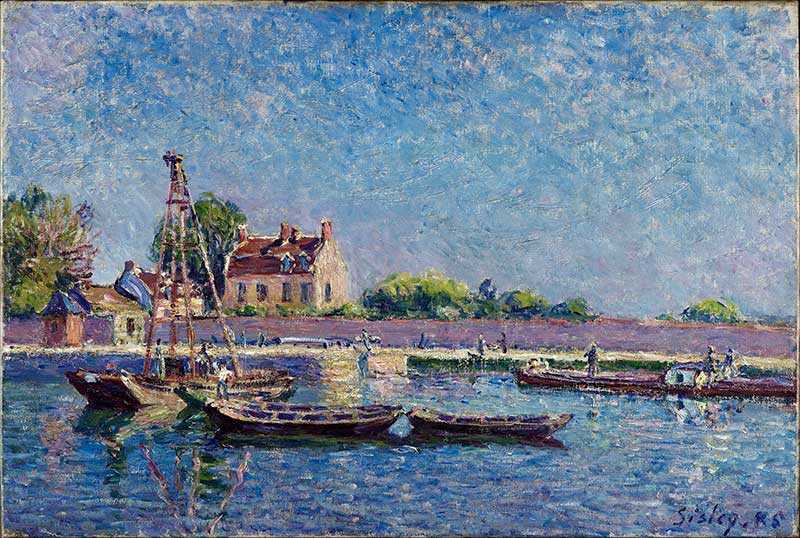1. Boulevard Héloïse, Argenteuil (1872)
‘Boulevard Héloïse, Argenteuil’ was completed very early in Sisley’s career.
The Franco-German War of 1870-71 and the failure of the Sisley family business prompted Sisley to pursue painting full-time.
In this work, we see him experimenting with plein air painting, drawing on the principles he learnt at the studio of Charles Gleyre, along with other Impressionist artists like Auguste Renoir, Camille Pissarro and Claude Monet.
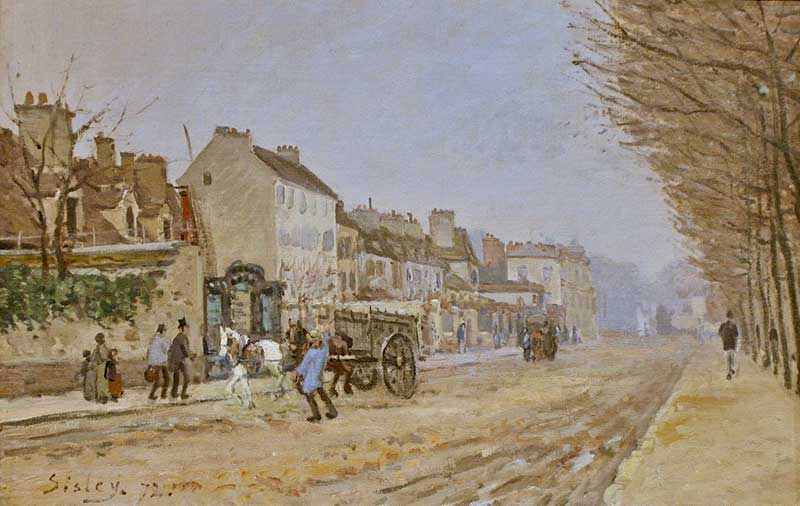
Argenteuil
With the expansion of the railways, Argenteuil became more accessible to city dwellers, including the Impressionists.
From the Gare Saint-Lazare in Paris, the artists could reach Argenteuil in less than 30 minutes. Hence, it became a popular location to observe Parisians at their leisure and experiment with painting water-themed works on the banks of the Seine.
Boulevard Heloise
For ‘Boulevard Héloïse, Argenteuil’, Sisley set up his easel on one of the main streets in Argenteuil.
For this particular project, Monet joined him too. The two friends worked on capturing the effects of natural light on the streets and the sky. Sisley paid particular attention to the subtle tones of the winter sky, reproducing the feeling of an overcast and damp day.
This type of subject suited Sisley perfectly as he was committed to the Impressionist goal of capturing the effects of light on different subjects. In this way, he followed the path laid down by the Barbizon School and artists like Boudin and Corot who had experimented with plein-air painting.
A quick sale!
Sisley sold the painting to Durand-Ruel’s gallery in Paris where it was purchased two years later by Adolphe A. Tavernier, a writer, art critic and journalist. Tavernier was one of Sisley’s most avid collectors and the two maintained a close connection until Sisley’s death in 1899.
2. Flood at Port Marly (1872)
In December 1876, great floods hit Marly-Le-Roi, causing destruction of homes and properties.
Sisley approached his paintings of the flooding with a neutral eye, depicting the scenes with a certain tranquility rather than a desire to capture drama or the power of nature.
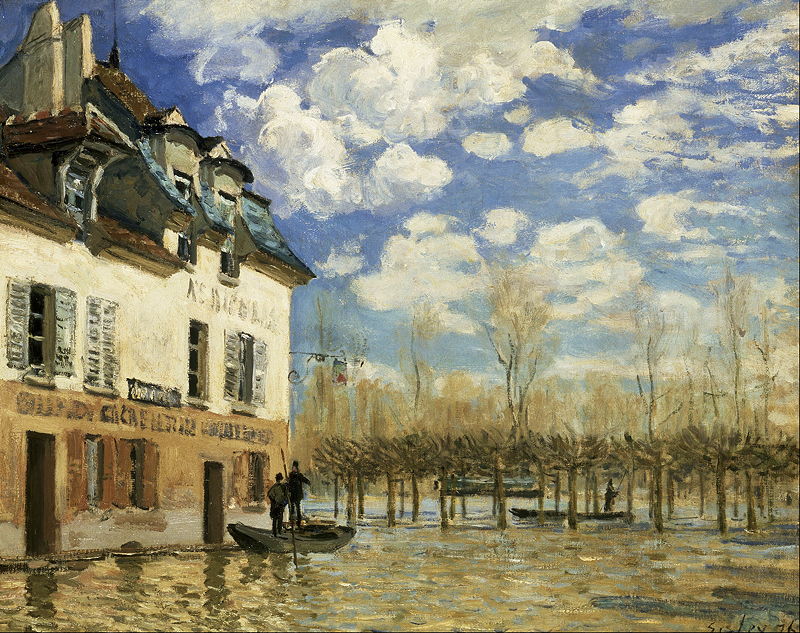
Sisley and floods ...
This was not the first time he had painted flooding; in fact, he had done so several times at Louveciennes and Hampton Court. In total Sisley painted six canvases of the flooding in Marly, usually completing each work in a single day. Monet also worked on views of the flooding around the same time.
‘Flood at Port Marly’ is one of the most impressive of Sisley’s his career. It features a wine merchant’s house completely surrounded by water so that it almost seems as though it is floating.
The reflection of the building is mirrored in the water, captured with short, delicate brushstrokes and nuanced tones. For the building itself, Sisley used different brushstrokes. The windows are painted as broad blocks of colour while the roof tiles are made from dabs of darker paint.
Structure
Whilst Sisley absorbed himself in painting the subtle reflections and light effects generated by the flooding, the composition is extremely structured. He used a combination of horizontal and vertical elements to create a sense of perspective and framing. The building sits at the edge of a vast waterscape, the last solid form in the landscape.
3. Molesey Weir, Hampton Court (1874)
Throughout his career, Sisley returned to water scenes in his paintings.
He especially enjoyed playing with reflections on water, using different brushstrokes to express the effects of light and movement.
In ‘Molesey Weir, Hampton Court’, Sisley had the opportunity to paint reflections and rapidly moving water too.

The Lock
The viewpoint faces upstream, looking towards west London and the northern bank of the Thames, as well as Ash island. This particular lock was built in 1815 to control the flow of the Thames.
During droughts, the water level would become too low for barges to pass through so the lock allowed goods to continue moving regardless of the weather conditions.
Capturing Water
In this painting, Sisley captures the turmoil of the water as it moves through the weir and the frothing spray beneath. He also used the grid-like structure of the lock to give the composition a complex, geometrical structure.
Sisley included bathers in the foreground of the scene to provide a sense of scale for the manmade structure. Molesey was one of the most popular locks on the Thames during the 19th century and many people would go there for day trips to swim and relax.
Sisley’s decision to paint people at their leisure next to such an impressive structure is indicative of the Impressionists’ aim to paint ordinary life.
4. Effet de Neige à Louveciennes (1874)
The piece was inspired in part by Courbet’s snowy landscape scenes which he exhibited in 1867.
Following the release of these works, a number of younger artists were motivated to paint their own snowscapes. Monet, Renoir and Sisley were among them.
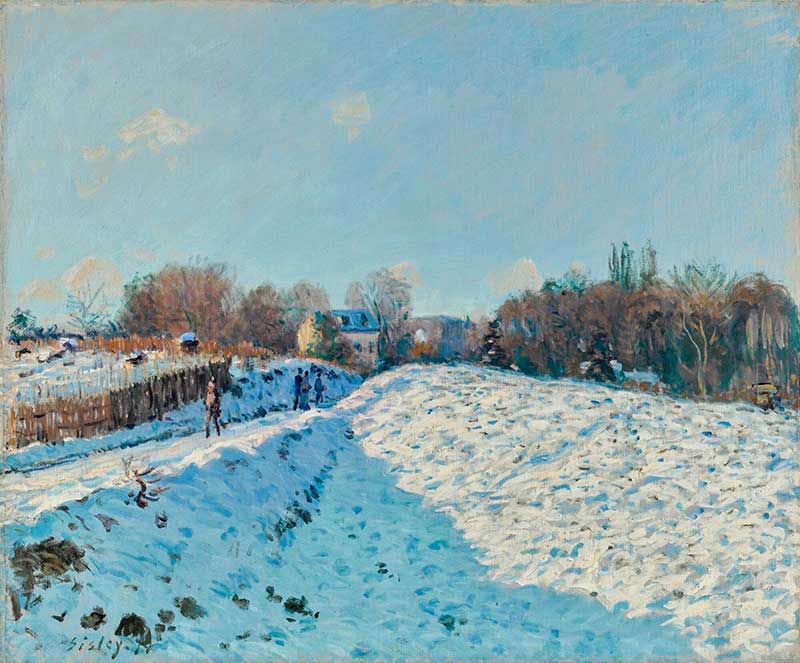
But Sisley was the one artist who continued to paint snow scenes for the rest of his career. One of the most stunning works of Sisley’s career, this snowscape from Louveciennes is a shining example of Sisley’s ability to capture natural light with great sensitivity.
Limited palette perfectionism
The artistry of snowscapes lies in the limited colour palette. It is necessary to paint the entire scene using only white and grey tones/shades with just small details picked out in colour. This particular piece is one of the finest he made.
The bright winter sunshine illuminates the scene, painted with short, sharp brushstrokes and a palette of blue and yellow on top of the whites and greys.
Shadows
To mimic the shadows falling in the foreground, Sisley used greens and lilacs, as well as cooler greys. Meanwhile, a large portion of the canvas is dedicated to the expanse of blue sky which contrasts with the snow-covered ground.
After moving to Louveciennes following the Siege of Paris by the Prussians in 1871, Sisley and his family then moved to Marly-Le-Roi. This piece was painted on a path to the side of the Route de la Princesse in Louveciennes, close to Sisley’s home.
5. The Watering Place at Marly-le-Roi (1875)
Sisley lived in the town of Marly-Le-Roi from 1874 to the summer of 1877.
One of the places he painted most frequently was the watering trough for horses, which features in his work almost 20 times.
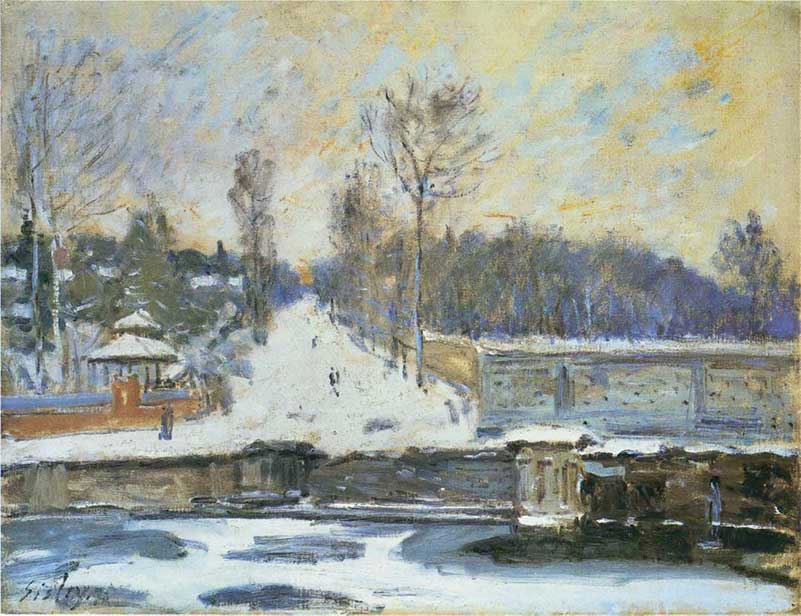
Louis XIV's Chateaux
The watering place survived from the old royal château that had once stood in Marly. The Château de Marly, built in the 17th century by Louis XIV, had been demolished following the revolution of 1789 and this was one of the few things that remained.
Sisley lived close to the old royal gardens, which may go some way to explaining why he chose this scene for his informal series. He painted the watering place in different weather and light conditions and from varying viewpoints. The watering place can be seen cloaked in snow and ice and in other pieces, bathed in brilliant summer sunshine.
One-sitting wonders
Many of these works Sisley would have painted in one sitting, moving quickly to capture the effects of the fleeting weather conditions.
In some pieces, the brown of the undercoat is still visible. The brushwork is quick and sketchy with extra detail added on top of the wet paint. Sometimes Sisley would go back and add further details in the studio once the paint had dried but the majority of the painting was done en plein air.
In this piece, the artist uses the vertical line of the road to structure the composition and balance the horizontal lines of the pool and the wall.
Sisley also devoted much of his energy to portraying the grey winter sky and the trees surrounding the watering place, highlighting the conditions of a cold, frosty winter day.
Learn more on our Sisley biography page.
6. The Bridge at Sevres (1877)
After Marly-Le-Roi, Sisley moved to Sèvres. He lived there between 1877 and 1880.
This rural area on the outskirts of Paris provided ample views for Sisley to paint. In ‘The Bridge at Sèvres’, Sisley captures a bright sunny day overlooking the Seine, using luminous colours to capture the effects of the sunlight.
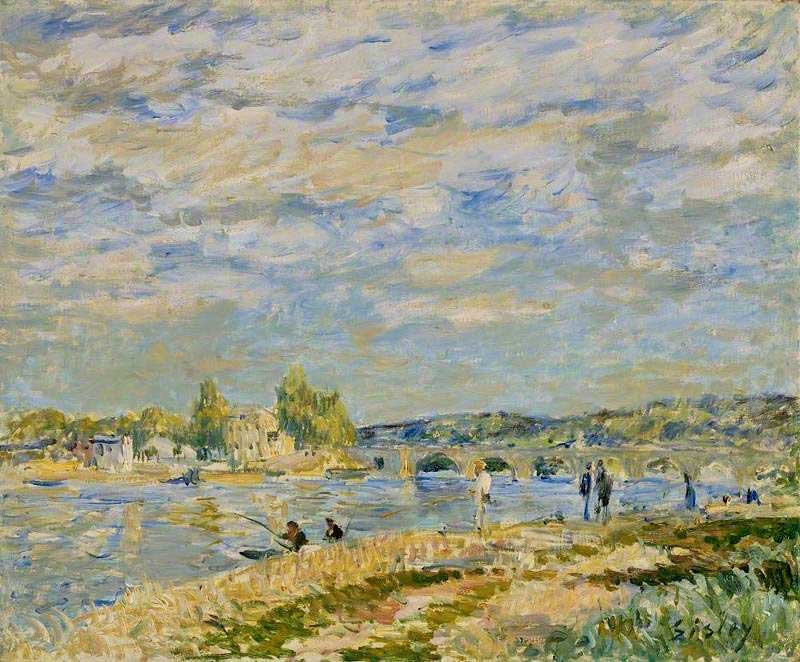
The houses of Billancourt can be seen on the left bank and Sèvres on the right.
Repetition
This particular bridge he painted no less than ten times. In each piece, he shifted the viewpoint slightly to get a different perspective on the structure. This amounts to an informal series of works, painted in the span of two years with most dating to 1877.
Most likely, he would have painted them within a short period of time.
Curved arches
According to Richard Shone, this bridge with the curved arches is a motif that runs through Sisley’s work throughout his career. In this piece, we can see images “that had mesmerized him since he began to paint.”
Describing his later work from Moret, Sloane draws links to certain motifs that can be seen in Sisley’s Sèvres paintings:
“Here were water, sky, reflections, a busy riverside; the multi-arched bridge was for the artist the last in a long line of such structures.”
This particular bridge was one of the first to captivate Sisley.
7. The Small Meadows in Spring (1880)
In 1880, Sisley left the suburbs of Paris and his home at Sèvres and moved to Veneux-Nadon.
Veneux-Nadon is located in the Seine-et-Marne region on the outskirts of Moret-sur-Loing.
Whilst staying in the area for two years, Sisley painted the region into his work. The move prompted a shift in his style with his paintings becoming fresher and more original. ‘The Small Meadows in Spring’ is one such painting, set on the banks of the river between Veneux and By.
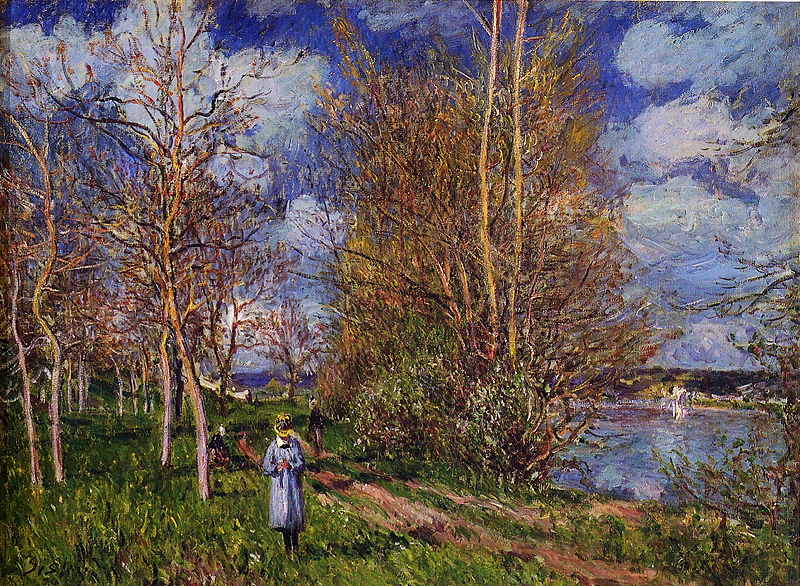
The girl in the painting was modelled by Sisley’s daughter, Jeanne-Adele Sisley. Born on 29th January 1869, Jeanne was Sisley’s second child and Renoir painted her portrait in 1875. With her blue coat and hat adorned with flowers, Jeanne echoes the Spring day around her in ‘The Small Meadows in Spring’.
This was one of a number of works Sisley painted on the path along the riverbank, known as Le Chemin des Petits Prés or the Path through the Small Meadows. A similar work, 'Les Petits Prés à By’ was exhibited at the Seventh Impressionist Exhibition of 1882.
At this time, this region on the banks of the Seine was rural but not long after Sisley painted these scenes, it rapidly industrialised.
An electrical factory was built nearby and the area underwent extensive development, including the building of housing for the workers.
8. Bords du Loing Près De Moret (1892)
This painting stands out among Sisley’s later works, he perfectly captures the brilliance of a sunny afternoon on the banks of a river.
Using short, quick brushstrokes and bold colours, Sisley drew on Post-impressionist painting techniques to produce this piece.
For much of his career, Sisley favoured lighter colours but in his later works he experimented with using stronger colours too, mixing paints with white to given them greater luminosity.
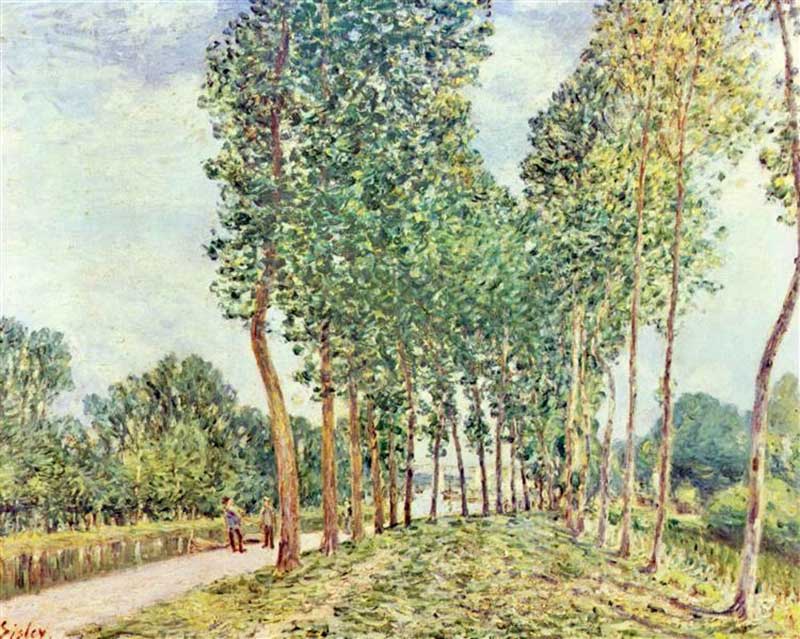
In this painting, the green of the trees is intense, set against a brilliant blue sky with pale clouds.
This particular line of poplar trees was an image that Sisley returned to frequently. He favoured the compositional effect of the receding line of trees.
This motif was borrowed from classical painting traditions, as seen in works like Meindert Hobbema's ‘Avenue at Middelharnis’ from 1689. There are also parallels to Monet’s work depicting the avenue of poplars at Giverny.
Sisley settled in Moret-sur-Loing in 1880 and lived there with his family until his death almost 20 years later.
During this time, he painted scenes from the town and the surrounding countryside. ‘The church at Moret in the Morning Sun’ from 1893 is another notable work from this period.
9. Sahurs Meadows in Morning Sun (1894)
During the summer of 1894, Sisley stayed in Le Mesnil-Esnard near Rouen.
He was a guest at the estate of François Depeaux, a wealthy industrialist known in Rouen as “the coalman”. As well as being a shrewd businessman, Depeaux was also a keen art collector and one of Sisley’s most prominent patrons.
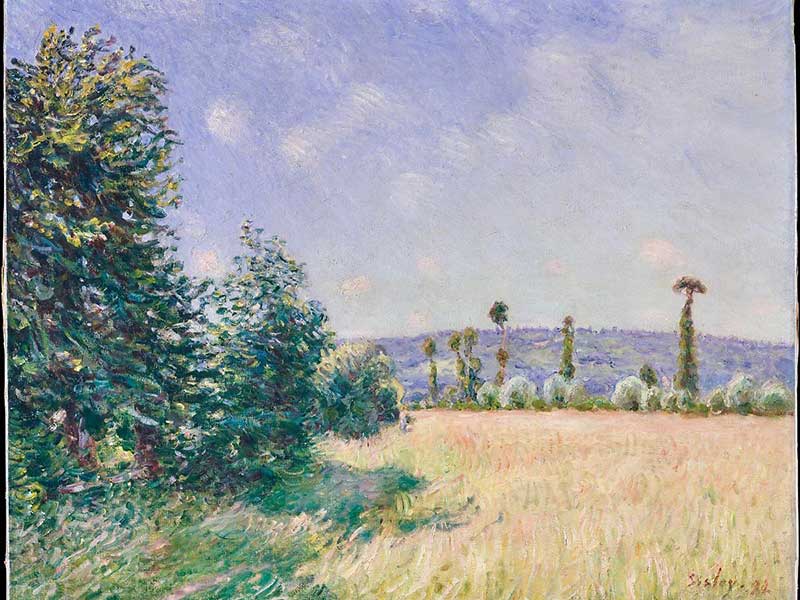
Depeaux began collecting Impressionist works in 1880. Over the next 40 years until his death in 1920, he purchased over 600 paintings, many of them by Impressionist and Post-Impressionist artists.
While staying with Depeaux, Sisley painted seven views of the Sahurs Meadows and the Coteaux de la Bouille. There are at least three works that feature almost exactly the same scene as this painting. Depeaux purchased five of the paintings.
In this piece Sisley seems to relish the great expanse of blue sky above the open meadow. As he described in a letter to his friend Adolphe Tavernier:
“The sky is not simply a background; its planes give depth (for the sky has planes, as well as solid ground), and the shapes of clouds give movement to a picture. What is more beautiful indeed than the summer sky, with its wispy clouds idly floating across the blue? What movement and grace! Don't you agree? They are like waves on the sea; one is uplifted and carried away”.
As well as the focus on the sky, this piece is also an example of the cropped composition that Sisley used frequently in his later career. As in many of his works from this period, the trees and foliage are cut off at the left of the canvas.
He uses gentle flicks of his brush to paint the lush greenery and the gentle yellow of the meadow.
10. Lady's Cove, Wales (1897)
Lady's Cove, Wales, is the final painting Sisley made before he died in 1899.
It is a piece that exemplifies his mastery of landscape painting, paying particular attention to the colours and atmosphere created by natural light.

Interestingly, this piece was painted from imagination, representing a new genre for Sisley. Though he was already gravely ill at this time, Sisley still managed to paint the work en plein air.
The dominant feature of the painting is the driving waves which dominate the diagonals of the painting. The colour palette is made up of greens and purples with yellowish tones added to the waves in the foreground.
Whilst this was to be Sisley’s last painting, in 1897 he painted several other works around Lady’s Cove and the Welsh coast. In total, there are 20 known works by Sisley painted in Wales, many of them bearing a similar palette of purples and greens.


